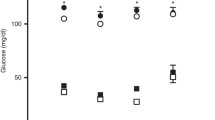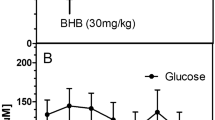Abstract
This study was designed to determine the effect of fasting upon cerebral hypoxic-ischemic injury. In the first part of the study the effect of fasting was determined for survival, brain tissue water and kation contents, and blood-brain barrier intregrity. In the second part of the study the administration of the substratesβ-hydroxybutyrate (BHB) and glucose has been evaluated regarding their influence upon the effect of fasting. The study used the Levine-Klein model of unilateral carotid occlusion and hypoxia because it mimics clinical situations of ischemia with hypoxia. The data show that fasting did protect rats from developing brain infarction following hypoxia-ischemia. Hypoglycemia seems to be involved in the mitigation of ischemic blood-brain barrier disruption. The plasma glucose level seems to be not the only factor involved in the genesis of the tissue kation changes. Starvation-induced ketosis probably does not play a role in the protection mechanism.
Similar content being viewed by others
References
Hawkins, R. A., Williamson, D. H., and Krebs, H. A. (1971). Ketone-body utilisation by adult and suckling rat brain in vivo.Biochem. J. 123:13–18.
Kirsch, J. R., and D'Alecy, L. G. (1979). Effect of altered availability of energy yielding substrates upon survival from hypoxia in mice.Stroke 10:288–291.
Kirsch, J. R., and D'Alecy, L. G. (1984). Hypoxia induced preferential ketone utilization by rat brain slices.Stroke 15:319–323.
Leon, L. P., Chu, D. K., Snyder, L. R., and Horvath, C. (1980). Continuous-flow analysis for glucose in serum, with use of hexokinase and glucose-6-phosphate dehydrogenase coimmobilized in tubular form.Clin. Chem. 26:123–129.
Levine, S., and Klein, M. (1960). Ischemic infarction and swelling in the rat brain.AM A Arch. Pathol. 69: 544–553.
Mellanby, J., and Williamson, D. H. (1970). Acetoacetat. In Berkmeyer, H. V. (ed.),Methoden der enzymatischen Analysen, Verlag Chemie, Weinheim, pp. 1776–1779.
Myers, R. E., and Yamaguchi, S. (1977). Nervous system effects of cardiac arrest in monkeys. Preservation of vision.Arch. Neurol.34:65–74.
Owen, O. E., Morgan, A. P., Kemp, H. G., Sullivan, J. M., Herrera, M. G., and Cahil, G. F. (1967). Brain metabolism during fasting.J. Clin. Invest. 46:1589–1595.
Welsh, F. A., Ginsberg, M. D., Rieder, W., and Budd, W. W. (1980). Deleterious effect of glucose pretreatment of recovery from diffuse ischemia in the cat. II. Regional metabolite levels.Stroke 11: 355–362.
Williamson, D. H., and Mellanby, J. (1970). D-β-Hydroxybutyrat. In Berkmeyer, H. V. (ed.),Methoden der enzymatischen Analysen, Verlag Chemie, Weinheim, pp. 1772–1773.




